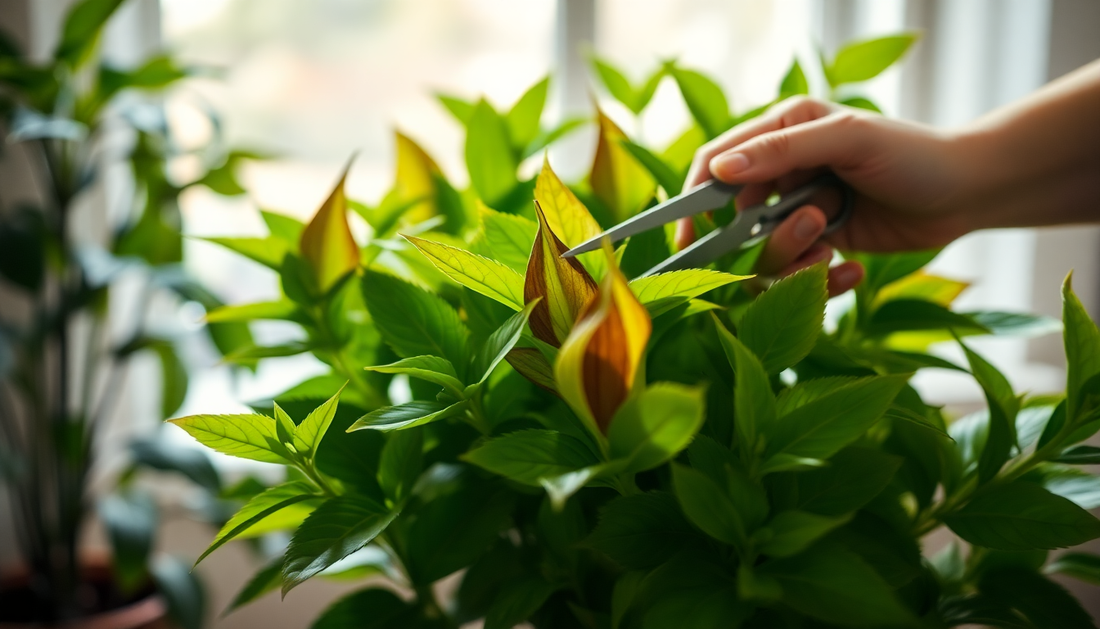
How to Fix Brown Tips on Indoor Plant Leaves
As an avid indoor plant enthusiast, I've encountered my fair share of challenges when it comes to keeping my leafy friends healthy and thriving. One of the most common issues I've come across is the dreaded brown tips on indoor plant leaves. This unsightly problem can be frustrating, but fear not! In this comprehensive guide, I'll share my expert tips and tricks to help you diagnose and remedy this common houseplant ailment.
Understanding the Causes of Brown Leaf Tips
Before we dive into the solutions, it's essential to understand the underlying causes of brown leaf tips. This condition can be triggered by a variety of factors, including:
Improper Watering
One of the most common culprits behind brown leaf tips is improper watering. Both overwatering and underwatering can lead to this issue. When plants are left sitting in waterlogged soil, their roots become stressed and unable to absorb the necessary nutrients and moisture, leading to the leaves drying out and turning brown at the tips.
Conversely, if the soil is allowed to dry out completely between waterings, the plant will also struggle, resulting in the same unsightly brown leaf tips.
Fertilizer Burn
Another potential cause of brown leaf tips is fertilizer burn. When plants are over-fertilized or exposed to high concentrations of certain nutrients, the delicate leaf edges can become damaged, leading to the characteristic brown discoloration.
Low Humidity
Indoor plants, especially those native to tropical or subtropical regions, thrive in environments with high humidity. When the air is too dry, the plant's leaves can lose moisture, causing the tips to turn brown and crispy.
Temperature Stress
Sudden changes in temperature, whether too hot or too cold, can also stress plants and contribute to the development of brown leaf tips. Exposure to drafts or placement near heating or cooling vents can exacerbate this problem.
Pest Infestations
In some cases, brown leaf tips can be a sign of a pest infestation. Insects like spider mites, aphids, or scale can feed on the plant's leaves, causing them to dry out and discolor.
Underlying Health Issues
Lastly, brown leaf tips can sometimes be a symptom of a more serious underlying health issue, such as a nutrient deficiency or disease. If the problem persists despite your best efforts, it's always a good idea to consult with a plant expert or horticulturist for a proper diagnosis.
Fixing Brown Leaf Tips: Step-by-Step Guide
Now that we've identified the potential causes, let's dive into the solutions to help your indoor plants regain their lush, healthy appearance.
1. Adjust Your Watering Routine
The first step in addressing brown leaf tips is to ensure you're providing your plants with the right amount of water. Start by checking the soil moisture levels regularly. Stick your finger into the soil up to the second knuckle – if the soil feels dry, it's time to water. Conversely, if the soil is consistently soggy, you'll need to cut back on the watering.
When you do water, be sure to thoroughly soak the soil until it drains out the bottom of the pot. Avoid letting your plants sit in standing water, as this can lead to root rot and other issues.
2. Fertilize Wisely
If you suspect that fertilizer burn is the culprit, it's time to reevaluate your feeding schedule and the type of fertilizer you're using. Opt for a balanced, slow-release fertilizer and follow the manufacturer's instructions carefully. Avoid over-fertilizing, as this can quickly lead to salt buildup and damage to your plants.
3. Increase Humidity
To combat low humidity, consider investing in a small humidifier or misting your plants regularly. You can also group your plants together, as this can help create a more humid microclimate around them. Alternatively, you can place your plants on a pebble tray filled with water to increase the surrounding moisture levels.
4. Regulate Temperature
Ensure your plants are placed in a spot with stable temperatures, away from drafts, heating vents, or direct sunlight. If necessary, adjust the thermostat or move your plants to a more suitable location.
5. Inspect for Pests
Carefully inspect your plants for any signs of pest infestations, such as webbing, small insects, or discolored leaves. If you do find evidence of pests, treat the affected plants with an appropriate insecticidal soap or neem oil solution to eliminate the problem.
6. Prune Affected Leaves
If the brown leaf tips are isolated to a few leaves, you can carefully prune them off using clean, sharp scissors or pruners. This will not only improve the plant's appearance but also redirect its energy towards producing healthy new growth.
7. Assess Underlying Issues
If the brown leaf tips persist despite your efforts, it's possible that there is an underlying health issue at play. Consider consulting with a plant expert or horticulturist who can help you diagnose and address any deeper problems.
Preventing Future Brown Leaf Tips
To keep your indoor plants thriving and prevent the recurrence of brown leaf tips, follow these proactive measures:
- Establish a consistent watering routine, checking soil moisture levels regularly.
- Use a balanced, slow-release fertilizer and follow the recommended application schedule.
- Maintain optimal humidity levels, either through the use of a humidifier or by grouping your plants together.
- Ensure your plants are placed in a spot with stable temperatures, away from drafts and direct sunlight.
- Regularly inspect your plants for signs of pests and address any issues promptly.
- Prune off any affected leaves to encourage healthy new growth.
By following these tips and staying vigilant, you can keep your indoor plants lush, vibrant, and free from the unsightly problem of brown leaf tips. Remember, every plant is unique, so be prepared to adjust your care routine as needed to meet the specific needs of your leafy companions.
Happy gardening!






No comments